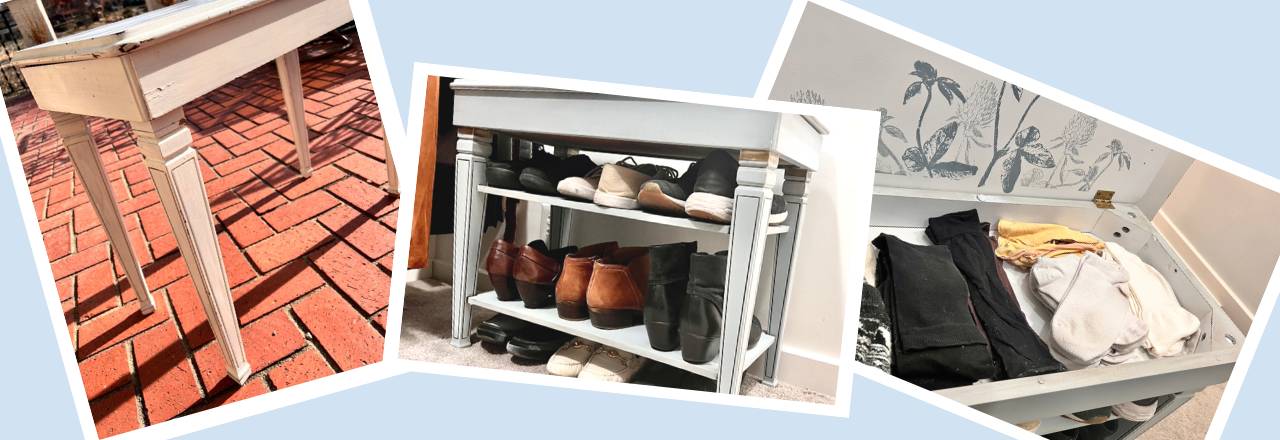
Easy How To: Bench With Shoe Storage to Solve Your Small Closet Woes
Turn a second hand piano bench into a closet bench with storage for shoes AND socks to help conquer your small walk in closet woes.
By nature, a closet is a small space. And it seems to grow smaller as we accumulate more “stuff”.
Closets are never big enough, right?
Oh but they can be with some organizing and clever storage solutions.
When we down-sized from our custom-built, large suburban family home to our quirky small home, the closets down-sized too!
Our last house, our walk-in closet was excessive. We didn’t set out wanting that, it’s just how the rooms fit together. But if the space was there, I managed to fill it, basically by never cleaning out and purging. I maybe wore twenty percent of the clothes in that closet.
It’s a good thing. Because the size of our current small closet is twenty percent of that last one! Fortunately it is still a walk-in. Well, more like a step-in.
Once we configured this one and eliminated all those “never-to-be-worn-again” clothes, we really don’t miss all that storage space one bit.
Well, once I made this addition, that is. See what worked for us!
- The Golden Rule of Storage: Think Vertical Space!
- Make a DIY Shoe Storage Bench — Of Course!
- What Needs to Be Added to This Bench
- Let’s Turn a Thrifted Piano Bench Into a Great Solution For Our Closet
- Conclusion
The Golden Rule of Storage: Think Vertical Space!
Shoes Are No Exception
Confession: I accumulate shoes, lots of shoes! Guilty!
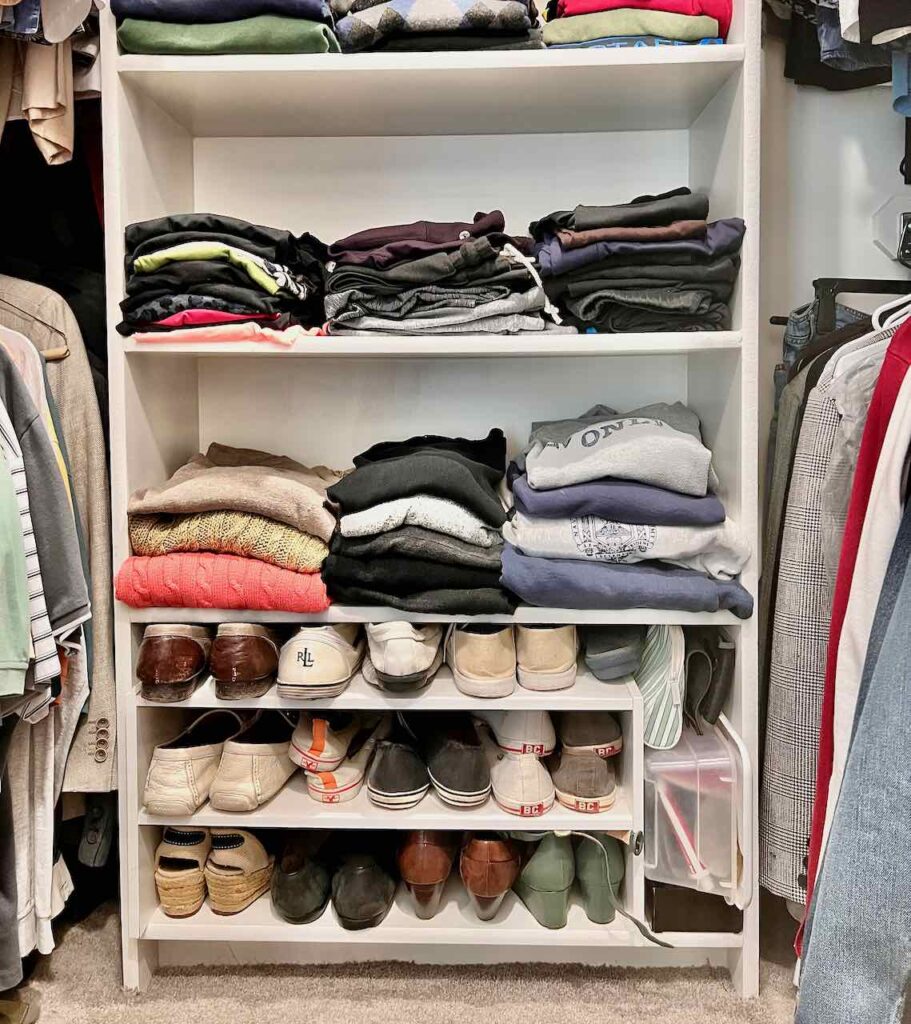
I have one of these small prefab shoe storage shelves that I slid into the bottom section of our only built-in floor to ceiling closet shelving. This shoe cubby holds the majority of my most worn shoes.
I tried valiantly to live with just the shoes that would fit that space. Honestly, I really did!
Summer I come close. Winter is another story.
First thought was to find an entryway shoe storage cabinet
But I also wanted a bench in our closet. A shoe cabinet alone was not enough.
See, I’m an early riser and I get ready for the day in this little closet that you enter through our bathroom. And then I try to quietly exit without waking the Hubs and our dog.
So next I looked for entryway bench with shoe storage, but they were all too big, or if they were sturdy and well built, they were too expensive. I found some that fit the size requirement, but if they also fit my budget, they were flimsy or just downright ugly.
What’s a girl to do?
Make a DIY Shoe Storage Bench — Of Course!
You can build a DIY bench from scratch, but I tend to look first to see if I can come up with an upcycle or makeover option. These tend to save me time and money.
And this one is no exception!
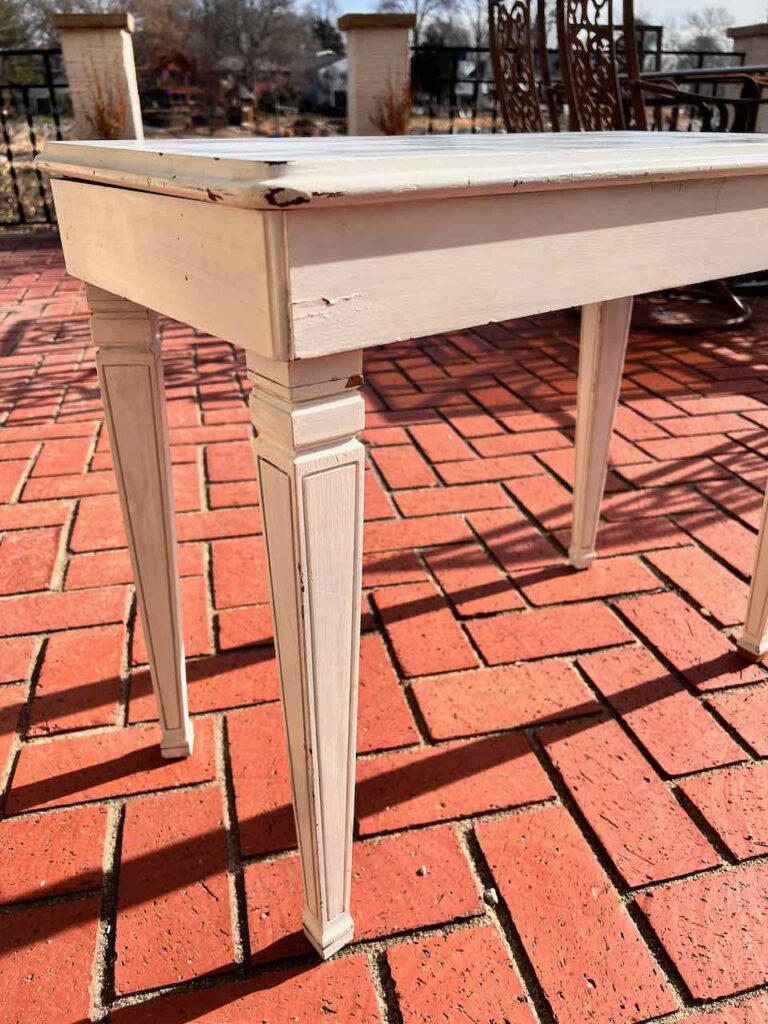
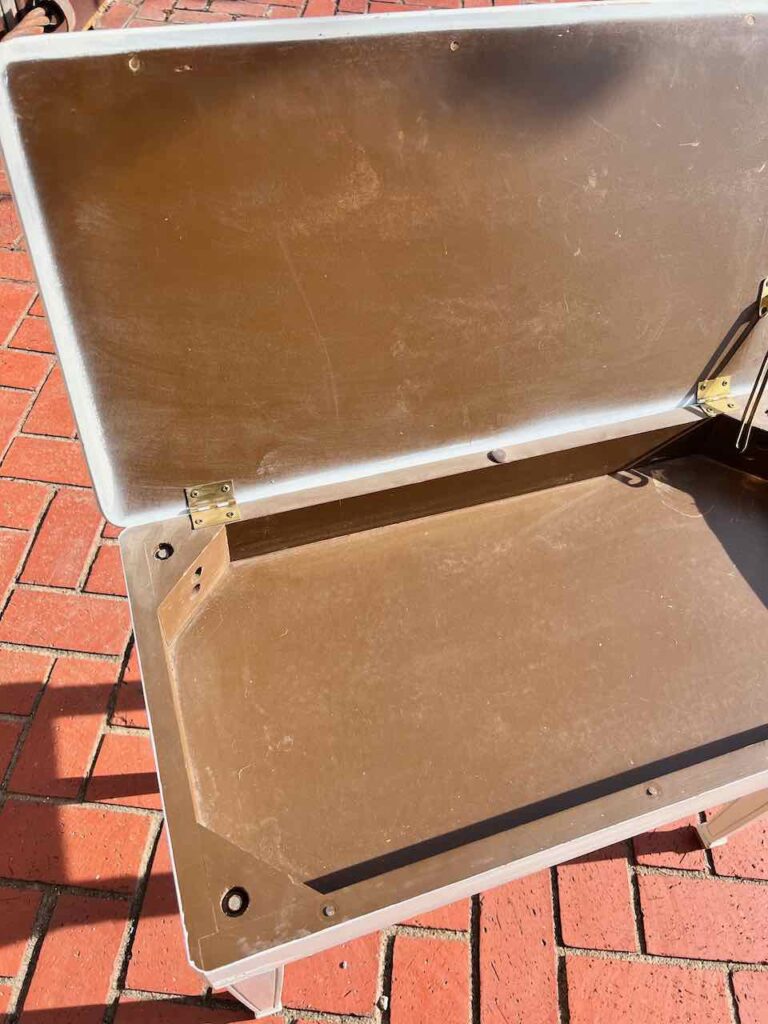
I found this great piano bench at a local thrift store for $8, and realized it would make the perfect base of the diy shoe bench. Then I paid $15 for the wood for the shelves. So my total investment was less that $25. Much better than building from scratch.
And the great thing about using a piano bench is the extra storage where sheet music is usually stored is the perfect place for storing socks!
What Needs to Be Added to This Bench
On the Pro Side:
- fits the little space perfectly
- very sturdy
- Bonus: Built-in storage for sox!!!!
- love that this bench is a bit taller than traditional bench
- the price!
On the Con Side:
- really bad paint job — that can be easily fixed
- no shoe storage — again an easy fix
Let’s Turn a Thrifted Piano Bench Into a Great Solution For Our Closet
The good news: It’s an easy diy with no detailed plans required!
Materials & Supplies:
- Piano bench or similar
- Wood cut to size for two shelves
- Shelf pegs
- Joint compound, optional, This is my go-to one!
- Paint, your choice or wood stain
- Glaze, optional
- Floetrol, optional
- Old t-shirts or lint free rags, optional
- Wax or sealer
- Tape measure
- Profiler or contour tool, or this set, optional
- Jigsaw
- Drill and bits
- Screwdriver or bits
- Sandpaper and sanding block Won’t do a project without this set!!!!
- Painters tape
- Paint brushes
- Misting bottle with water. Indispensable whenever I’m painting or finishing!!!
Here are some of the supplies and materials I used, or equivalents. These are affiliate links which means if you use these links, you pay the exact same amount, but I may receive a small commission that really helps me continue to bring you tutorials and valuable content. I truly appreciate you supporting me in this way!
Step 1) Prep the Bench for New Paint
As with most painting projects, the first thing is to remove all the hardware. In this case the lid to the piano bench had two hinges and a safety latch.
Based on the condition of your bench and it’s finish, prep for your new finish.
In my case, I really needed to sand the finish down as it was very uneven and pealing in places even though I was planning on a chalk paint finish.
I started sanding with 80 grit progressing to 220 grit sandpaper. And look what I discovered!!!
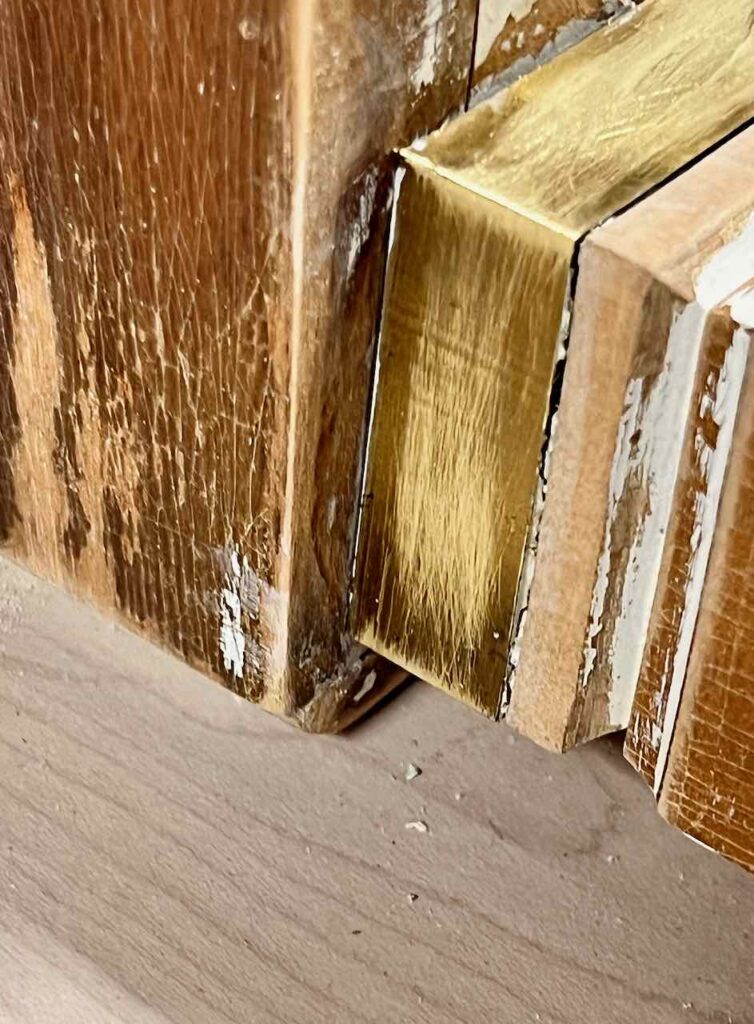
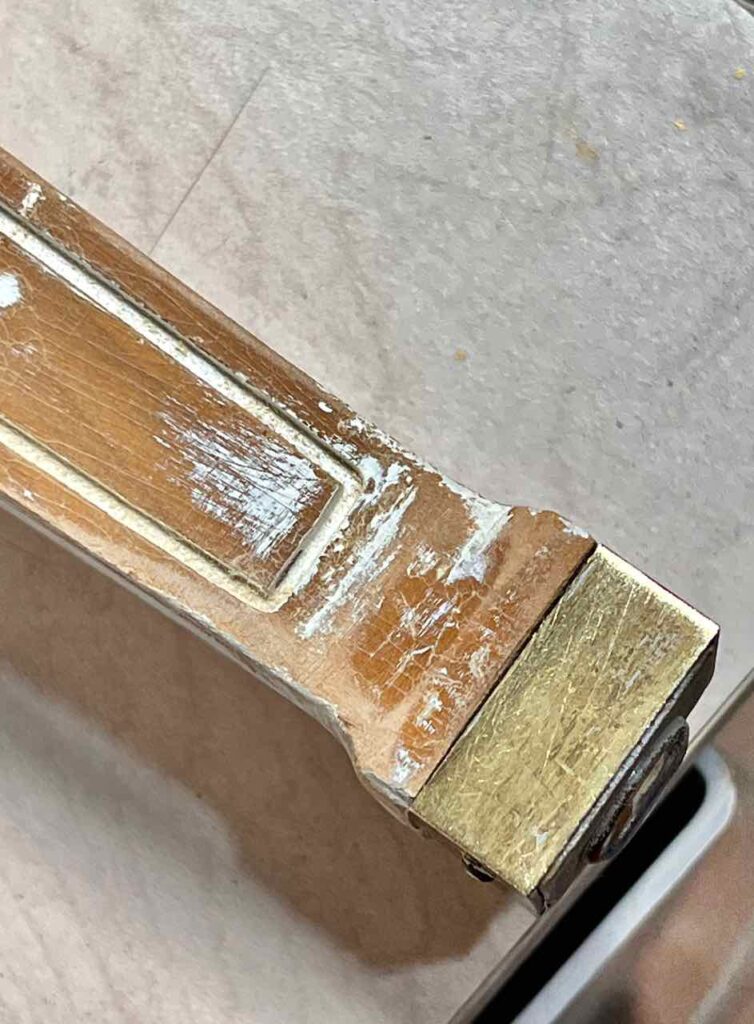
Yes, sweet brass trim at the top of each leg. Two of the legs also had it at the foot. Two were missing. But I quickly got over that tiny loss — it’s in our closet, the feet will be in plush carpet and it will never be noticed. And there’s always gold paint!!
Step 2) Add Shelves to Store Shoes
Adding shelves to a bench with open legs is an easy build.
A) Determine height of shelves-
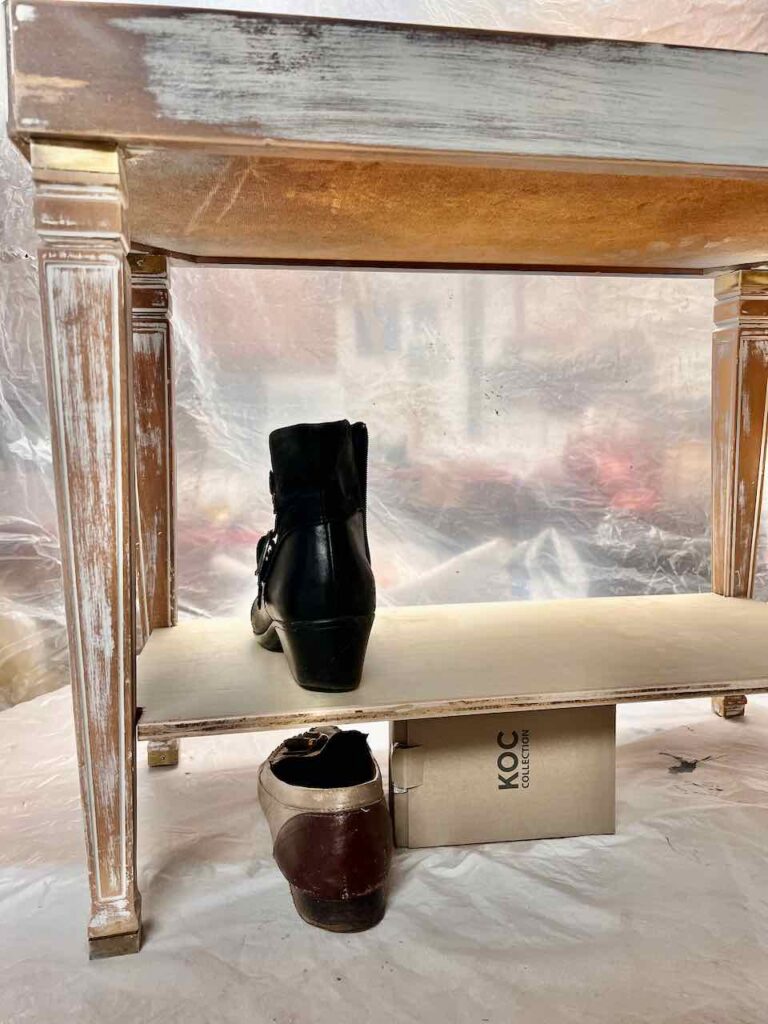
I used a variety of boxes with three different pairs of shoes to determine the shelf heights that would be best for my shoes. It’s important to plan for high heels vs flats, vs. sneakers vs. booties.
If you think you want an adjustable shelf, maybe winter boots vs. summer flip flops, just drill the extra holes now at those potential heights.
B) Drill holes for shelf pegs
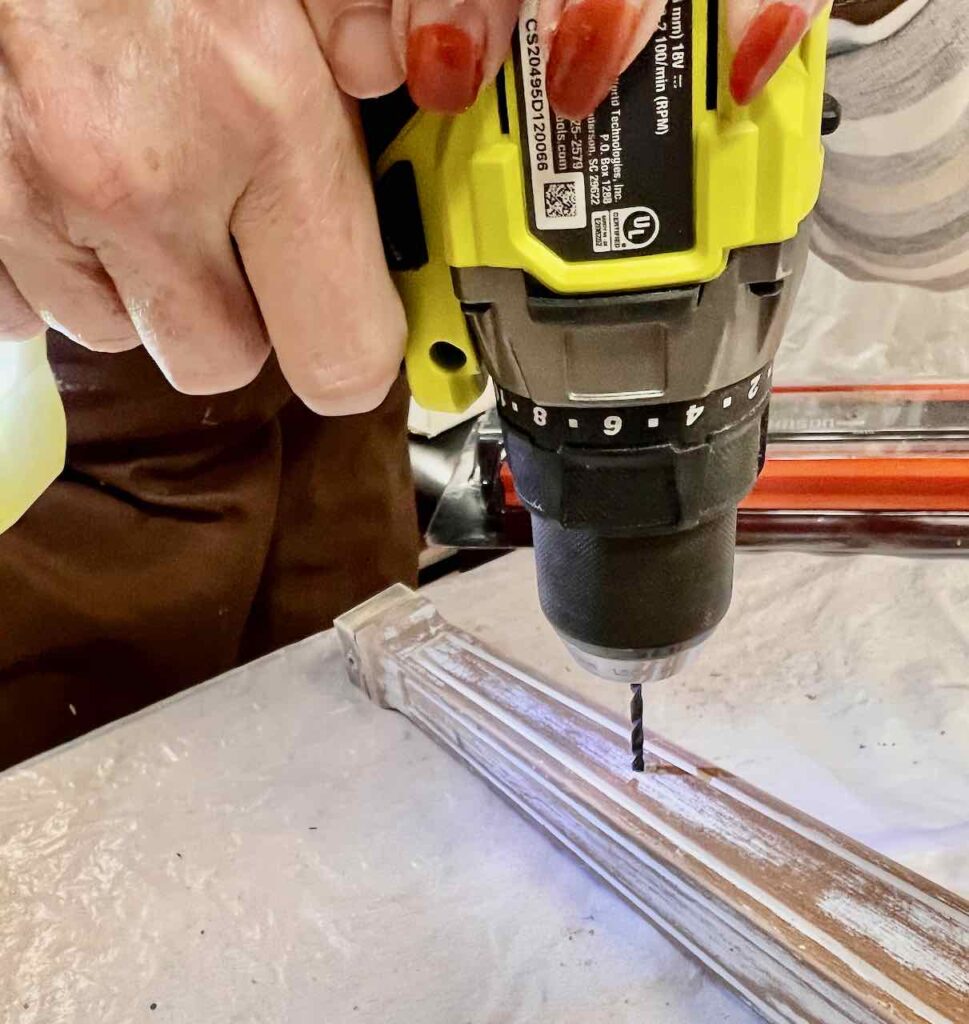
Once I knew the placement of my shelves, I started by drilling the holes for the shelf pegs.
TIP: Always start with a thin pilot hole to avoid splitting the leg.
My pegs are 1/4-inch pegs, so I used a 1/4-inch drill bit. You may be tempted to go slightly larger with your bit, but DON’T. It’s important to have a snug fit.
I didn’t need any kind of a shelf pin jig. I just made sure my markings were at the same height on all four legs.
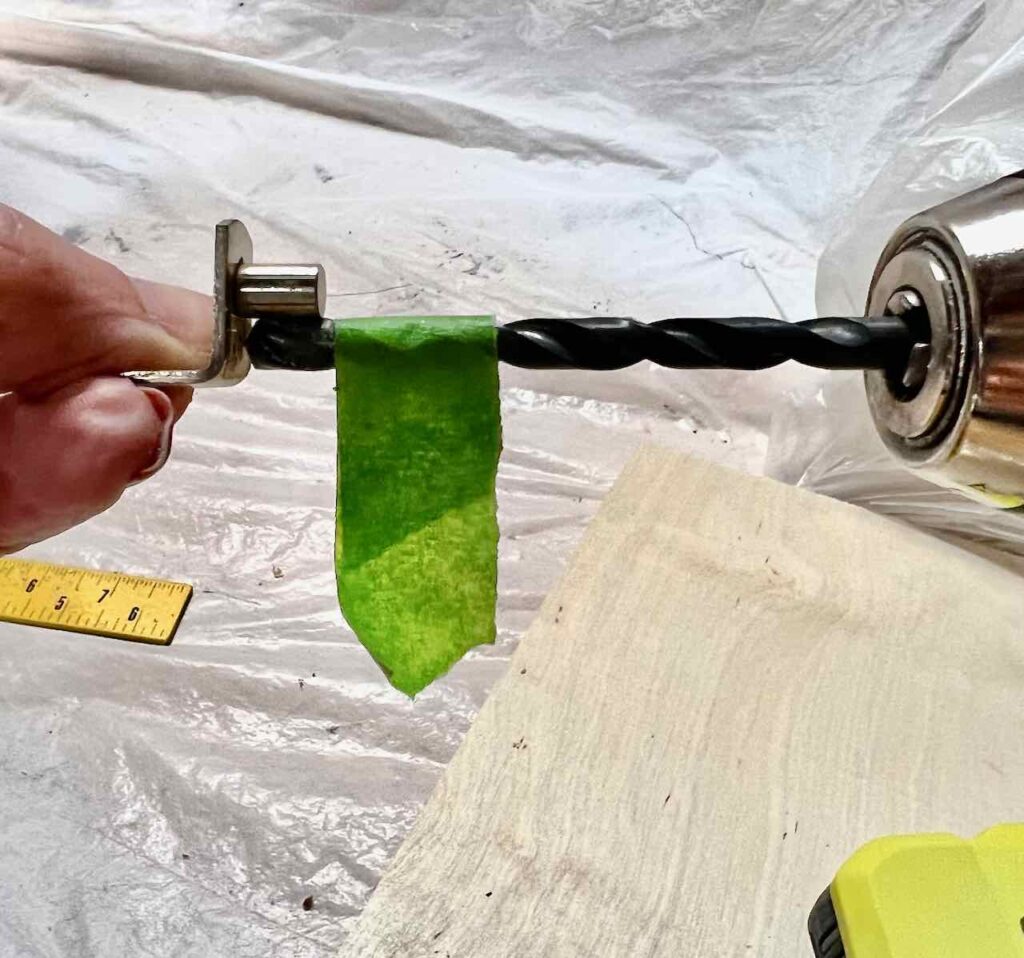
TIP: Easy way to drill the right depth — wrap a piece of painters tape around your bit slightly longer than the length of the peg.
C) Cut and prepare shoe shelves
I wanted and suggest making shelves that wrap the inside corners of the legs. When the shelves wrap the corner, they cannot slide out of place either front to back or side to side.
The pegs simply hold the height. The legs hold the shelves in place.
I started by choosing a 2 x 2-foot piece of maple veneered plywood for my two shelves and had the fellas at the store cut it into two 12 X 24-inch shelves. Then all I had to do was notch the corners to fit around the bench legs.
Because the legs of my bench are tapered and not splayed exactly the same all around, I used a contour tool, sometimes called a profiler.
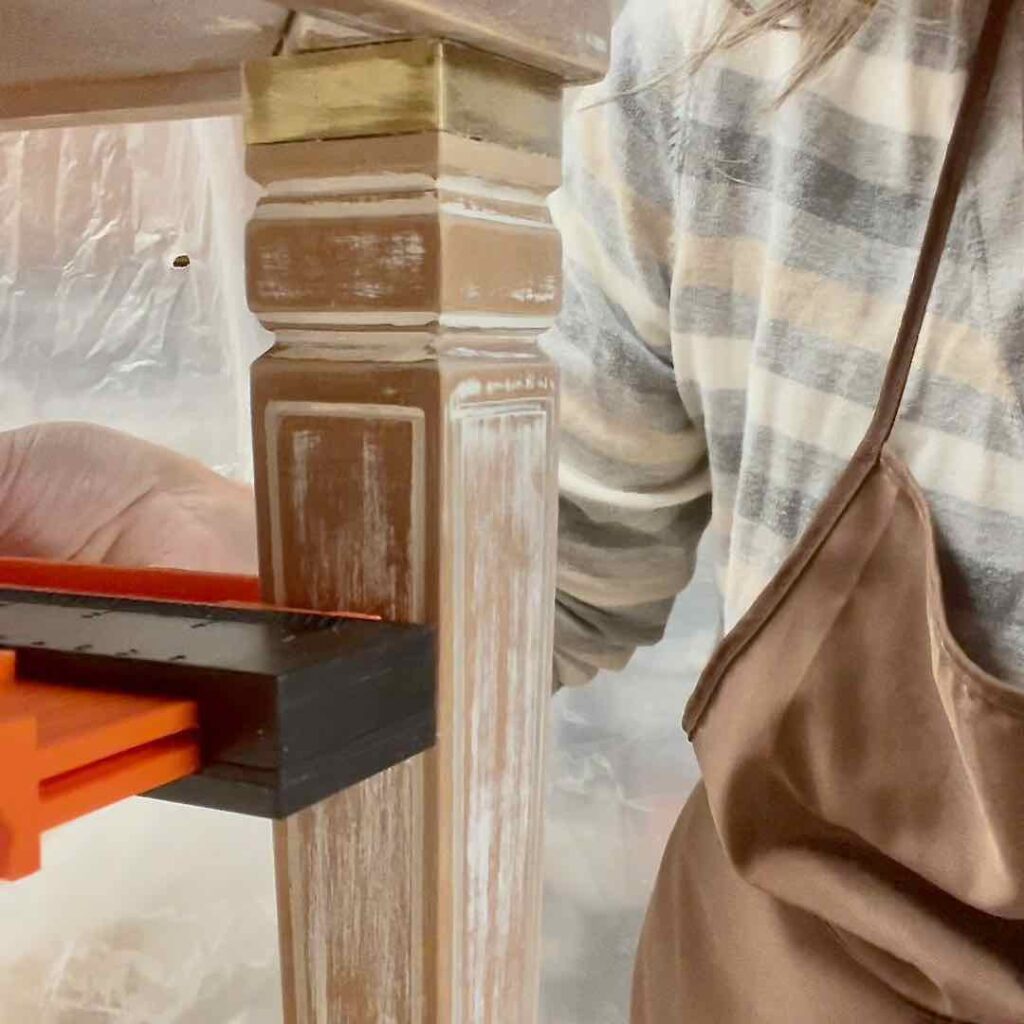
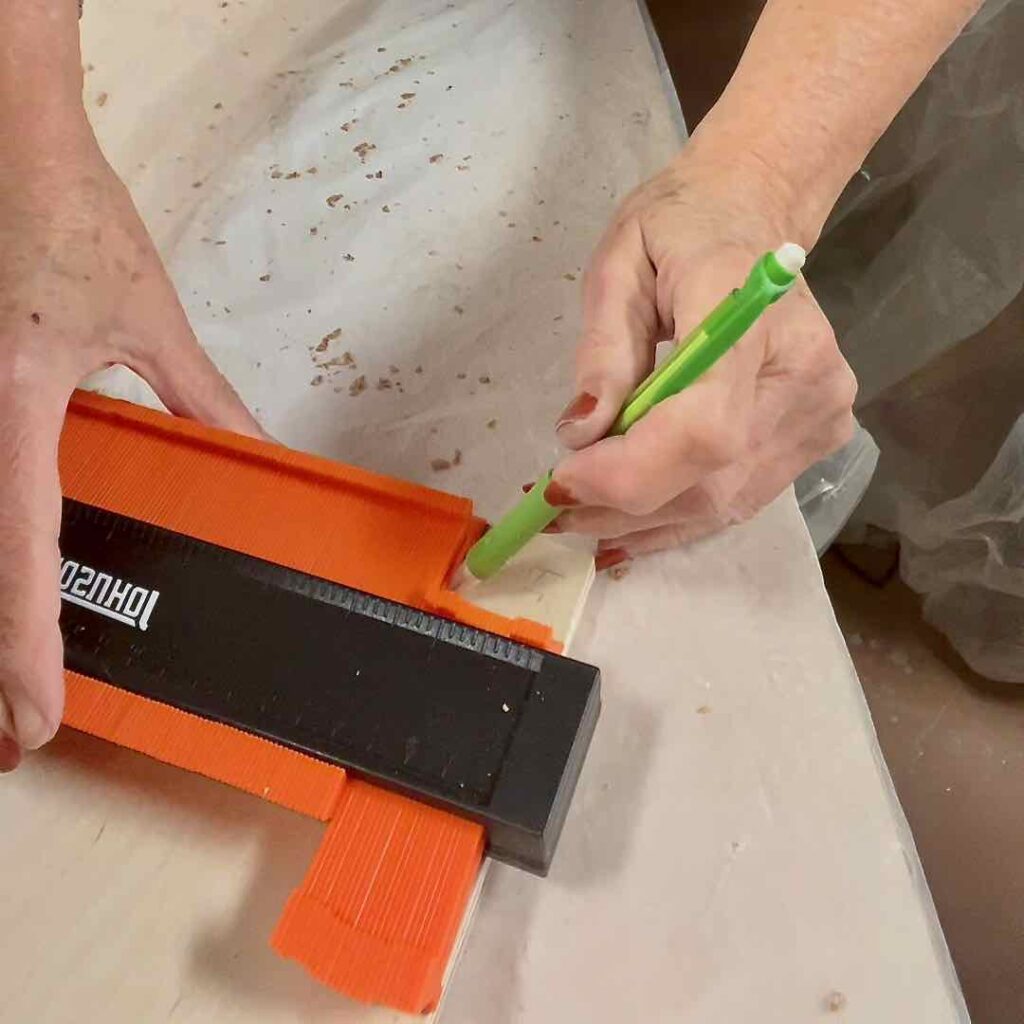
It’s simple to use and inexpensive to buy for all kinds of projects. I held the profiler up to the shelf peg with the edge aligned to where the shelf edge would be. Then I pushed the profiler against the leg and locked the tines in place.
Then I aligned it on the board and traced the lines to be my cut lines.
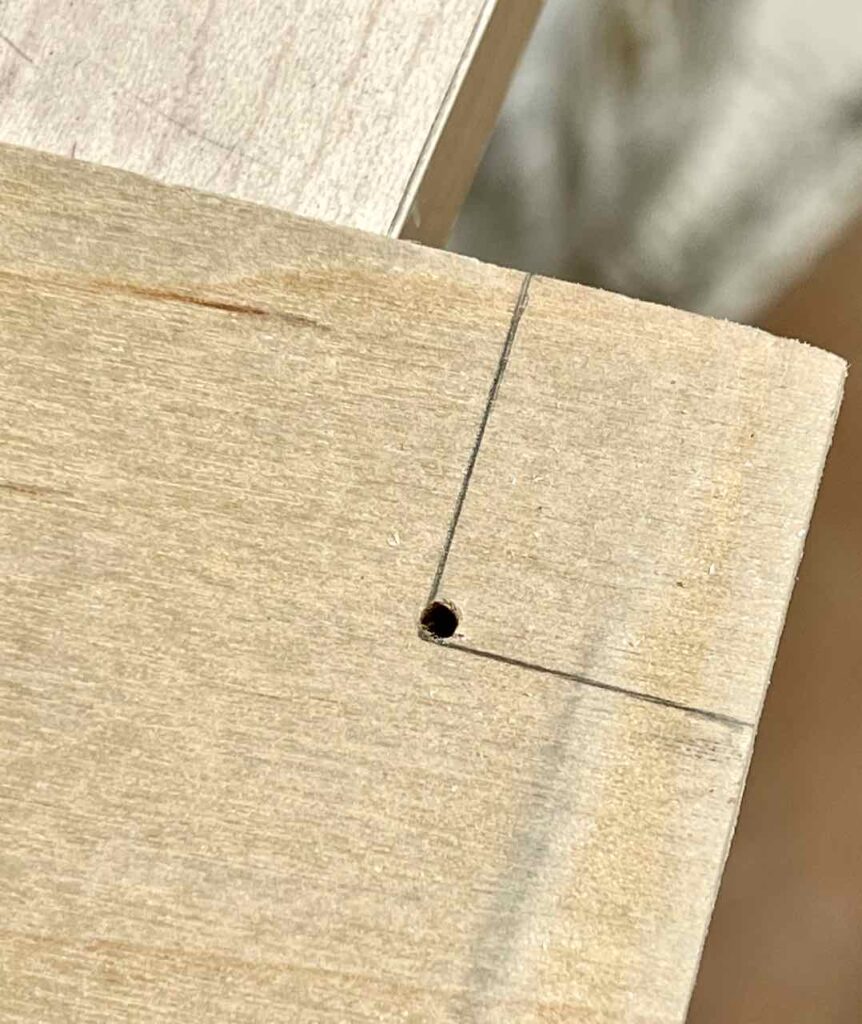
At each corner, I drilled a hole just to the inside of the notch. This helps me stop the jigsaw at the right spot for each notch.
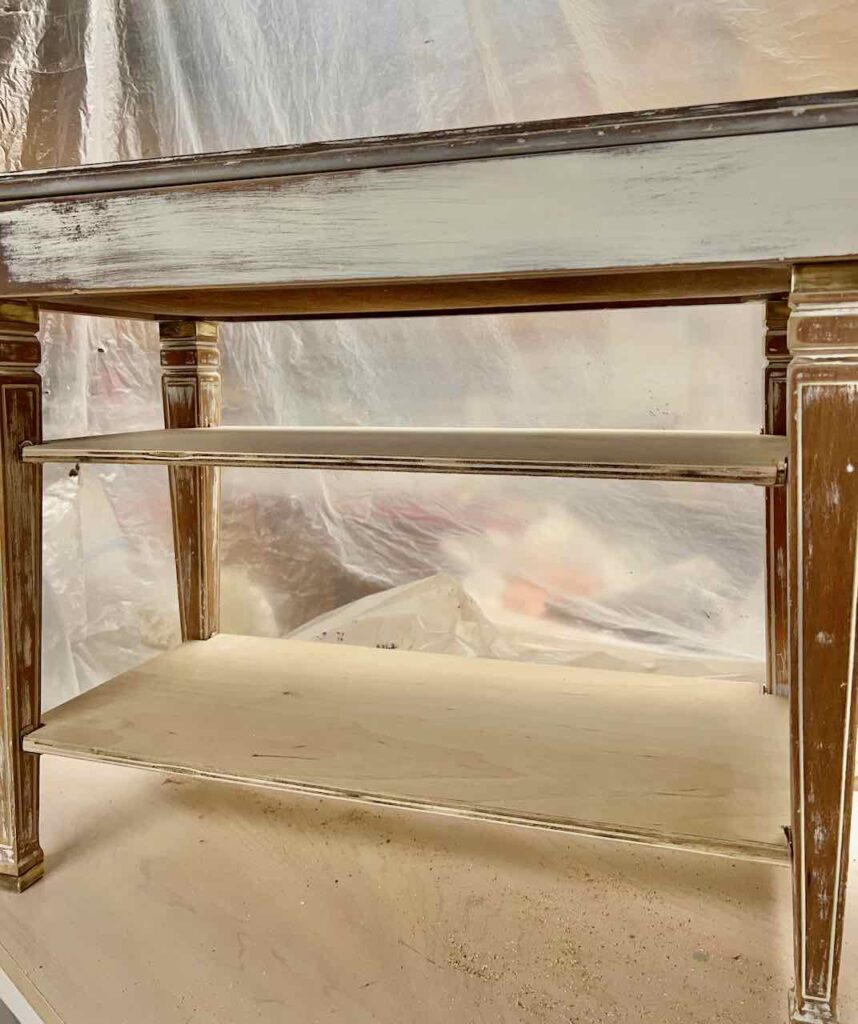
Test the fit and make any necessary adjustments.
D) Finish edges if plywood
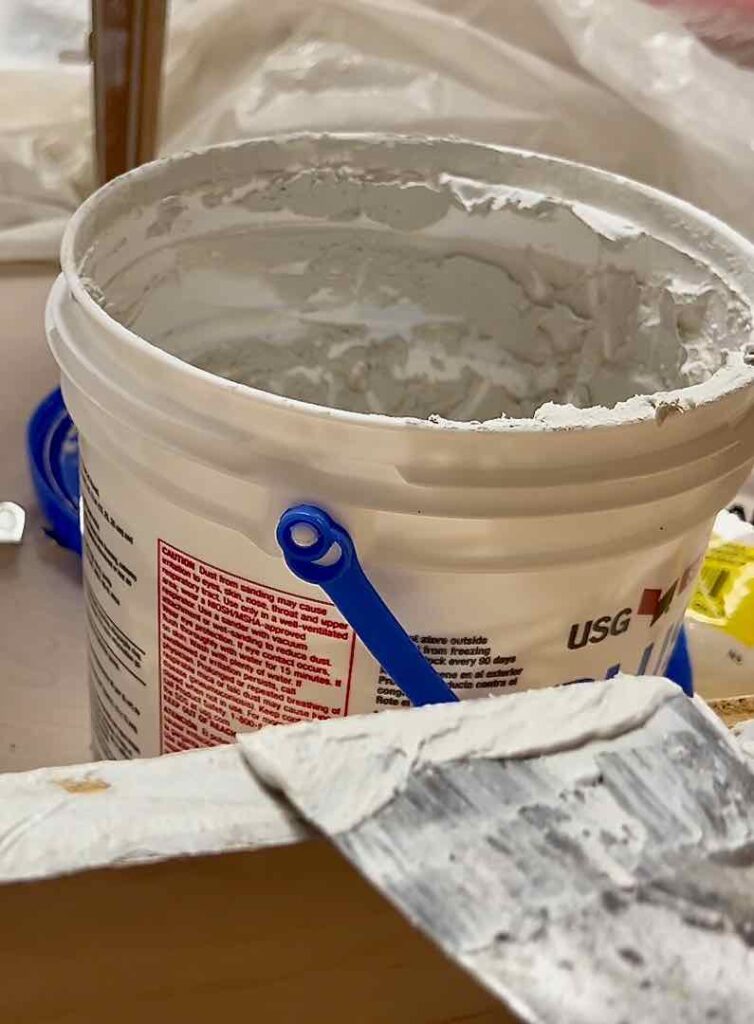
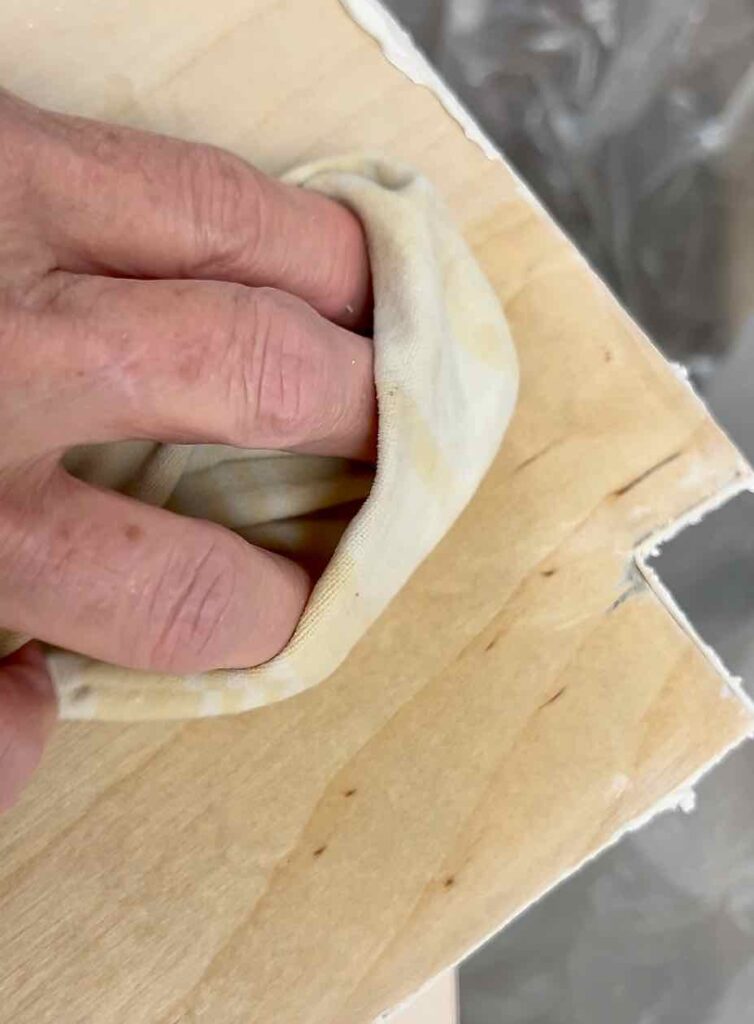
This is optional, but since I was using plywood, I finished the raw edges with a smear of joint compound filling in the raw edges.
Before it dries, wipe off any excess with a damp lint free rag.
Once the joint compound dries, sand it smooth and you’re ready for the finish treatment.
So easy and it makes such a difference!
Step 3) New Paint Treatment
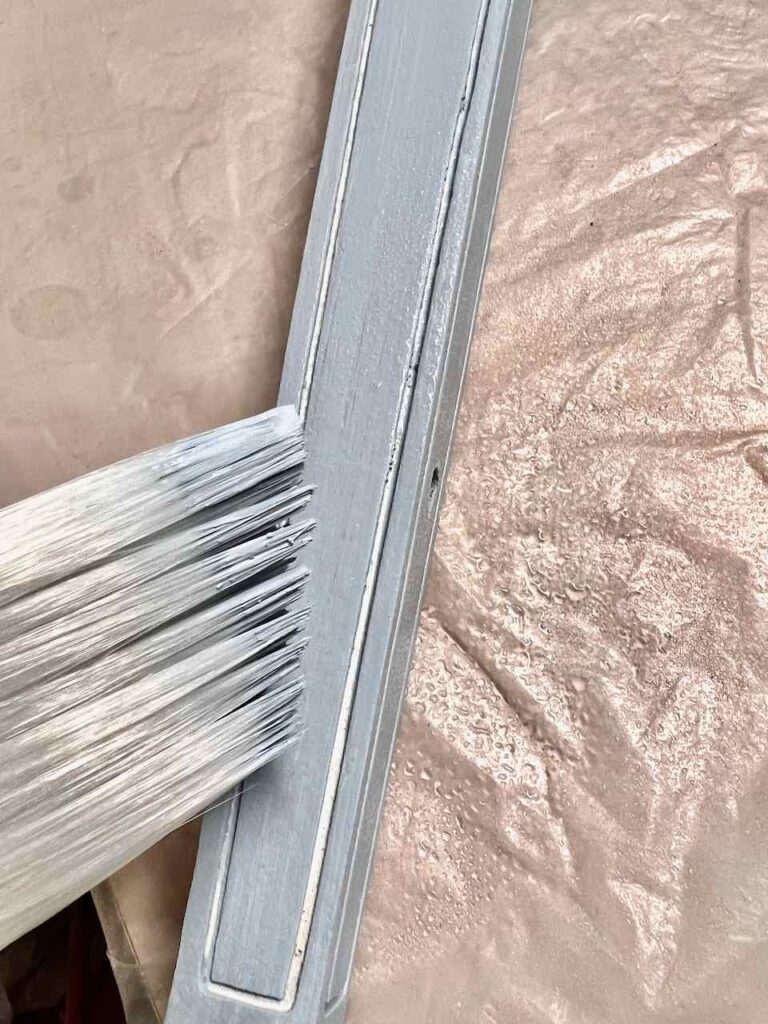
I used chalk paint. But of course use what you prefer, or maybe what you have on hand.
I had about half a quart of white chalk paint left over from another project. But I didn’t want white. I wanted a soft grey blue color. So into the approximately one pint of white chalk paint, I added approximately 3 Tablespoons of dark blue latex paint leftover from our front door.
HINT: Did you know you can tint chalk paint with latex paint? Yep, I’ve done it several times with no problems. I just would not add more than 10% of volume.
Because I was concerned about running out of my mixed chalk paint, I did a base coat of Zinsser white primer that I keep on hand, then followed that with two thin coats of my specially mixed blue chalk paint.
Optional Glazing or “Antiquing”-
Next I wanted to add a glaze. I keep a jar of glaze on hand. I have found that for some projects a black antiquing glaze is just too stark, So I have a jar of come black and brown craft paint mixed together for a warm mocha color.
To this I added 20% Floetrol. Floetrol is a miraculous additive for any latex or water-based paint. It extends the drying time to give you plenty of time to manipulate your paint effects. This also helps to eliminate brush strokes and roller marks even if you are not glazing or doing anything fancy. It gives the paint a longer window to self-level before it dries.
TIP: Always test any glaze or special effect on scrap wood.
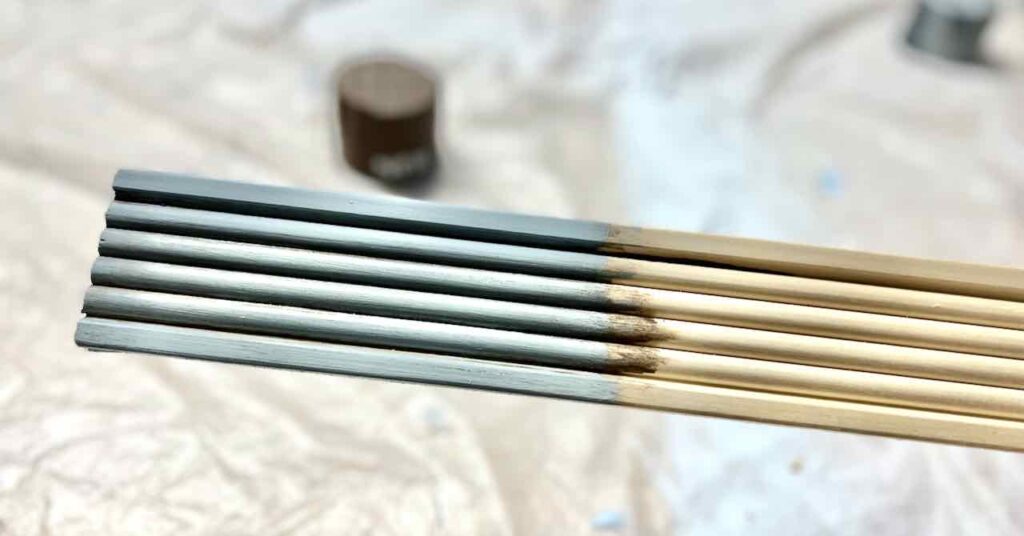
I tested the glaze on a scrap piece of fluted trim board and discovered that it changed the color of the blue too much even as i wiped it off immediately. This told me I needed to thin my glaze with water. In a dixie cup I mixed 1 part glaze mixture to 1 part water. Another test on my trim board and I had it perfect.
Spread the glaze with a brush making sure it seeps into all the cracks and crevices. Then immediately wipe off with lint free rags. Old t-shirts cut up are the best for this.
If you want more of the glaze color, wipe lightly. If you have too much color or you don’t like the way it looks in one spot, just give it a one pump mist of water and wipe it off. Experiment with it until you get the look you like. It is a super forgiving process and actually quite fun and creative.
Let this all dry overnight and then add protective coat of wax or a clear coat finish.
If you antiqued or glazed your bench, you may feel like it doesn’t need anything more because rubbing with the rags may have left a really polished, smooth surface. DON’T skip a protective surface! It still needs it!!!
Protect Your Finish
Yes, even though it may not feel like it needs it, Your bench will get heavy use, so be sure to protect your finish with whatever variety of topcoat works with your finish and your style.
BONUS: Don’t forget the inside of the storage seat! Might as well make it bright and fun to great you every morning!
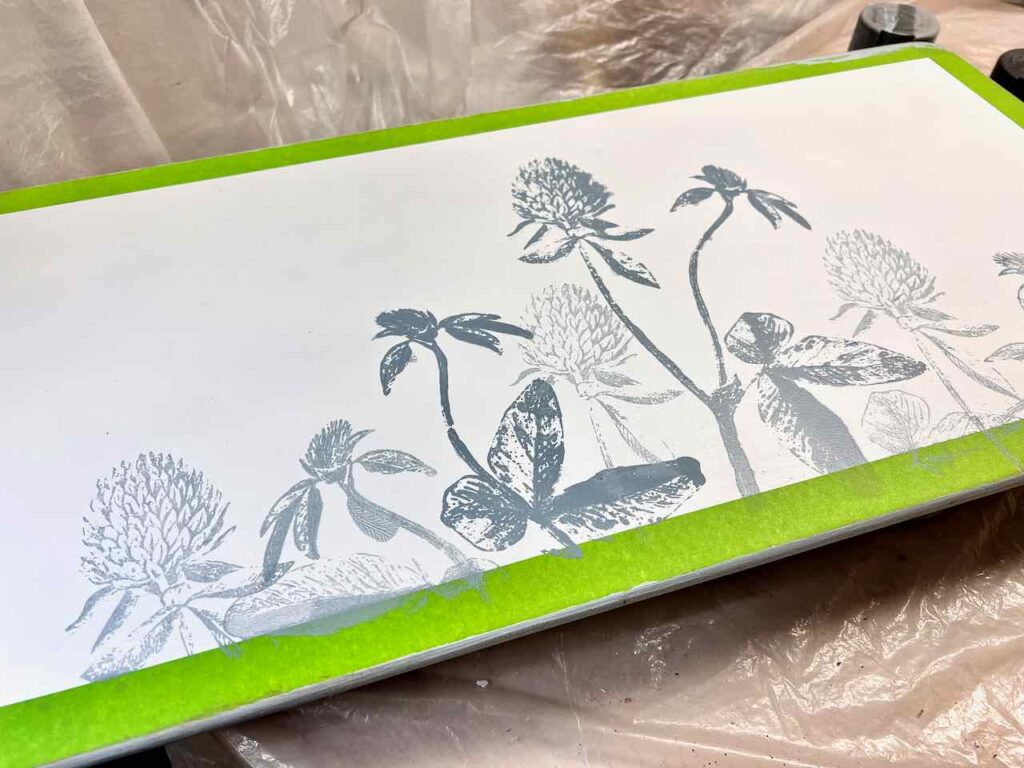
I painted mine white and then used a silk screen to experiment with a treatment I want to perfect for a project coming up. A fun contact paper or temporary wallpaper would be great as well as a stencil.
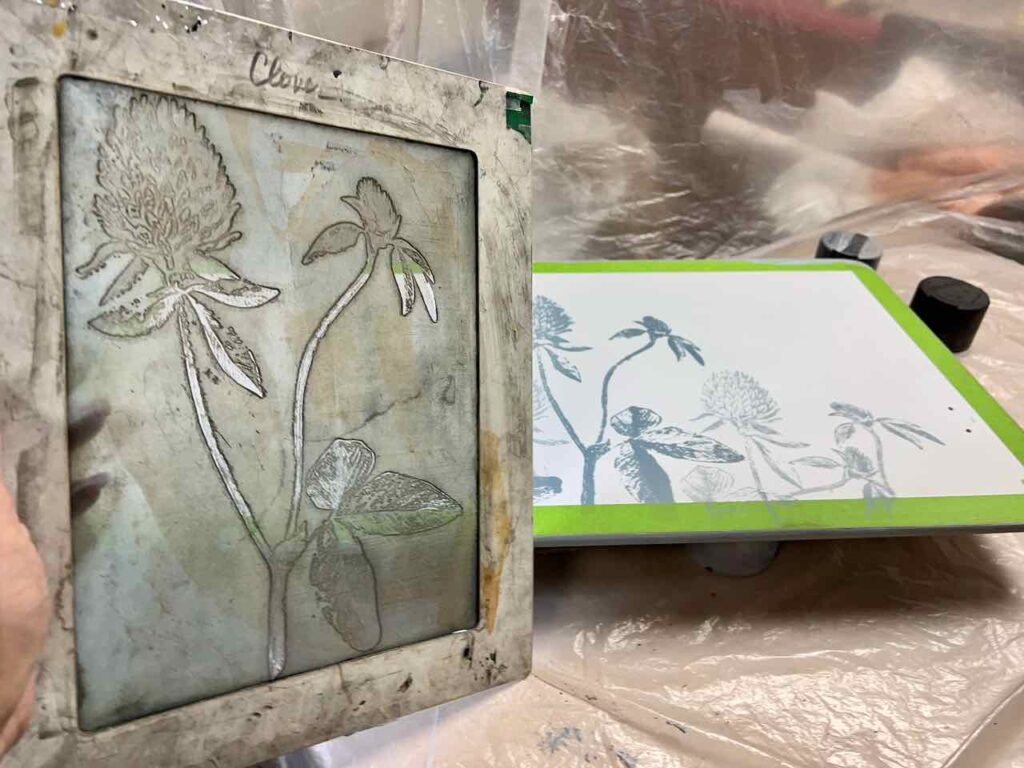
Speaking of up-coming projects: Are you a subscriber or follower? If you are, thanks bunches! If not, please consider signing up. Your email is never shared or sold. You control how much is right for you — and you can change it at anytime! AND you don’t need to worry about missing out.
Video Alternative
If you learn best from video, and some processes translate best with video, here is a short video (just over 5 minutes) that might be helpful. Click the image below to view.

Step 4) Assemble and Fill
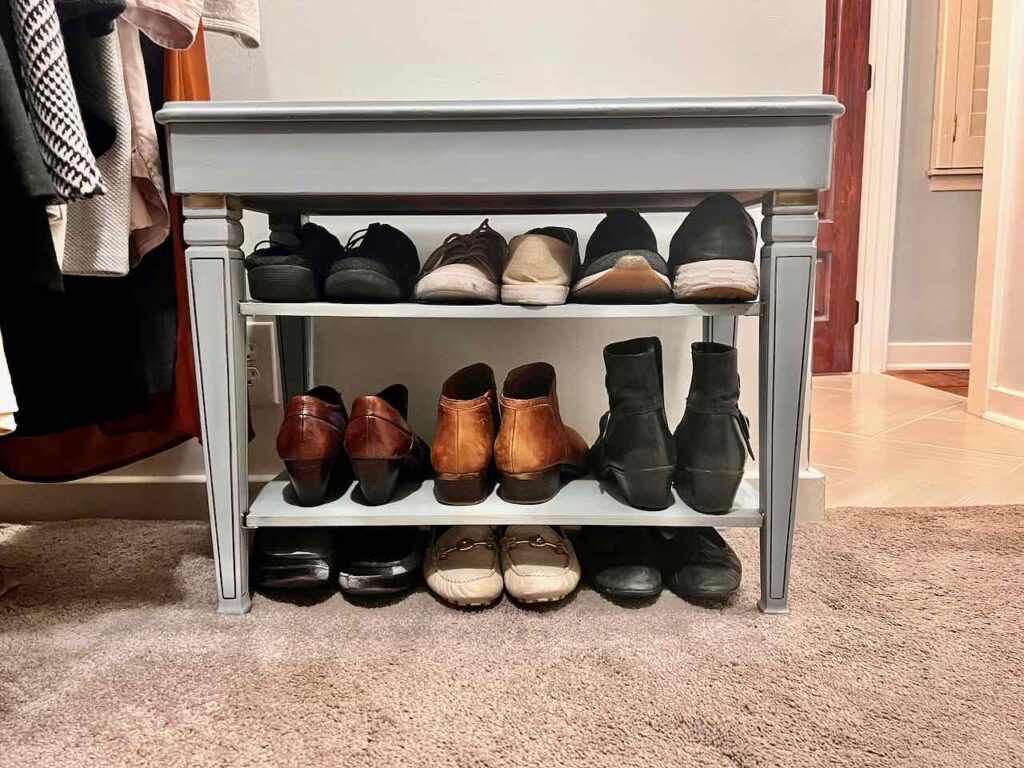
Start with your top shelf. Add the two pegs in the back legs. Slide the shelf under the bench vertically and set the back of the shelf on the brackets. Now holding the front up, insert the front two pegs and front of the shelf will rest right in place.
Repeat for the lower shelf.
Then reattach the lid and you’re set to go.
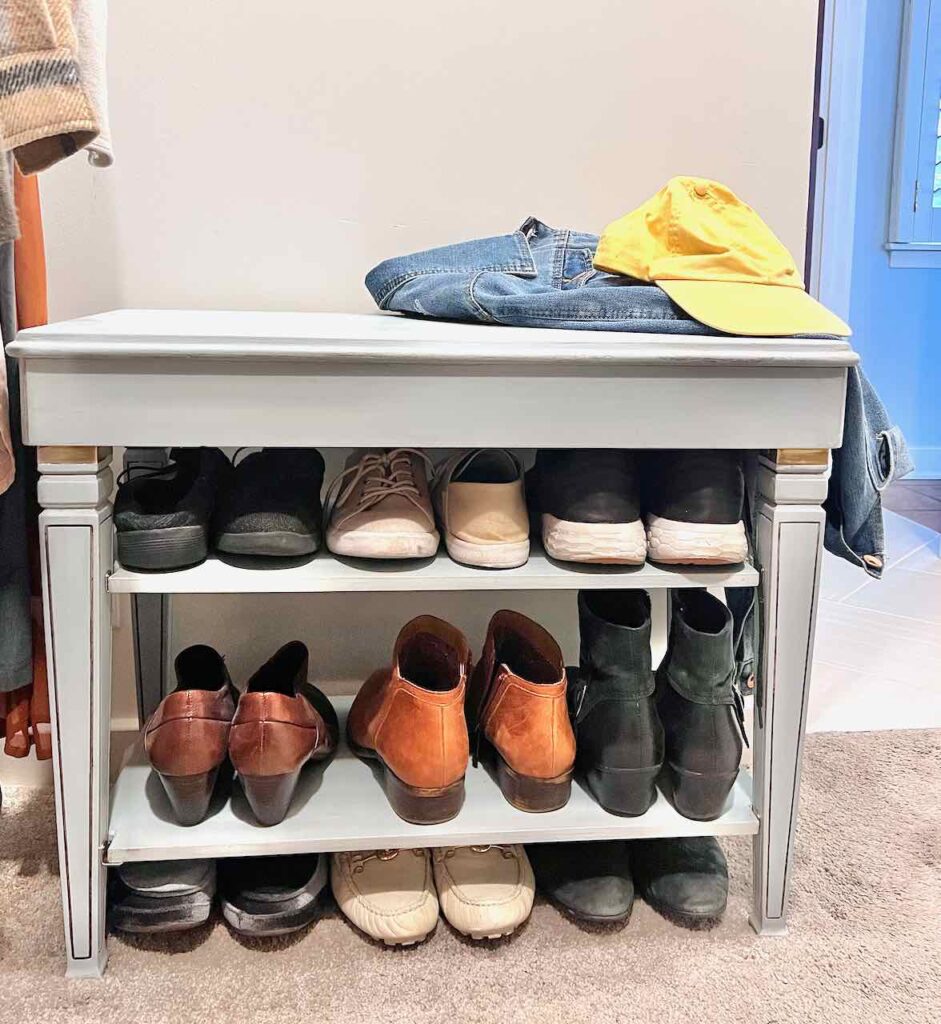
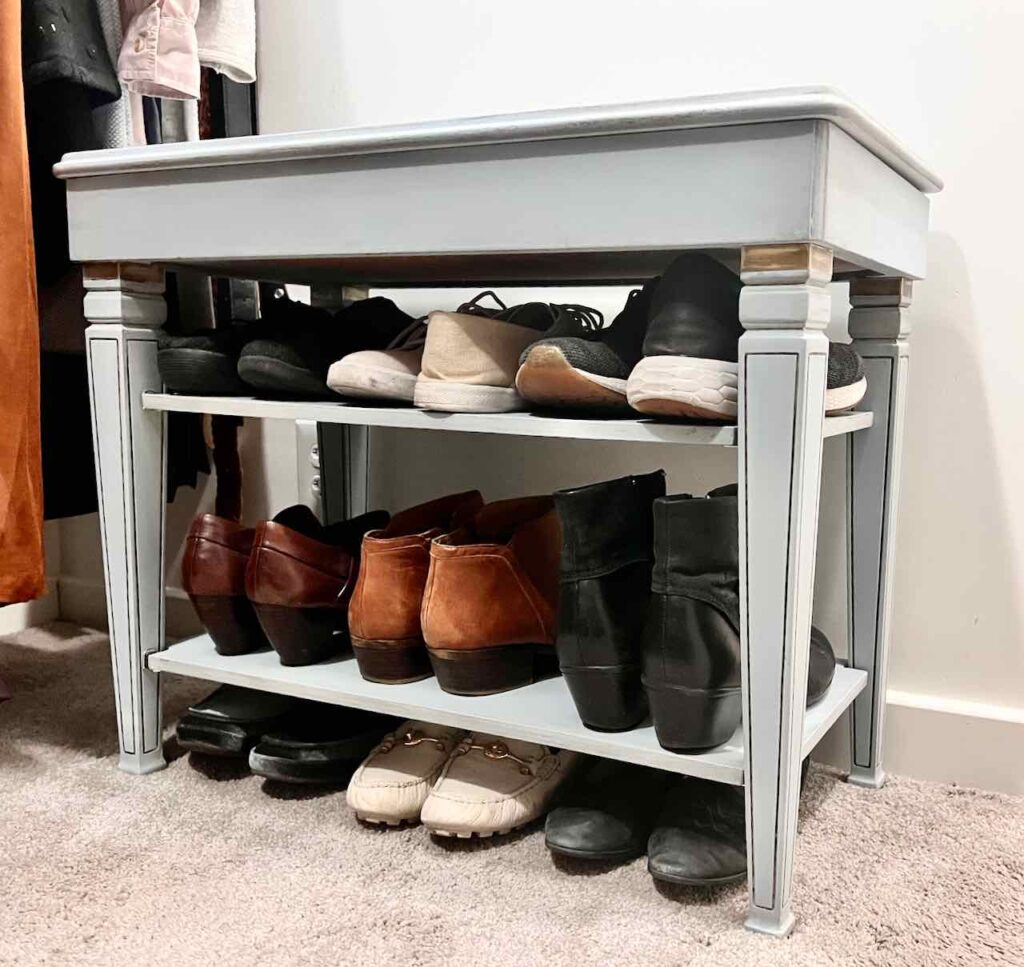
Conclusion
I found a piano bench to be the perfect solution for a lot of shoes in our new small step-in closet.
Look! No more shoe clutter!
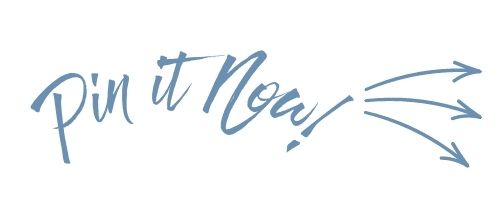
You’ll want it when you come across an old piano bench to solve some storage problems at your home.
Save it to your
Storage board
Organizing board
Closet Makeover board
Wherever you’ll be able to find it again.
(go ahead share it with your friends too ?)

Interested in more organizing and storage ideas? Check these out:
I don’t know about you, but I love to start my day with everything in it’s place. No chaos! It makes me feel lighter and more energetic!
How about you? What helps you start your day off right?
I hope this eliminates a spot of frustration for you making space for more joy in your home.


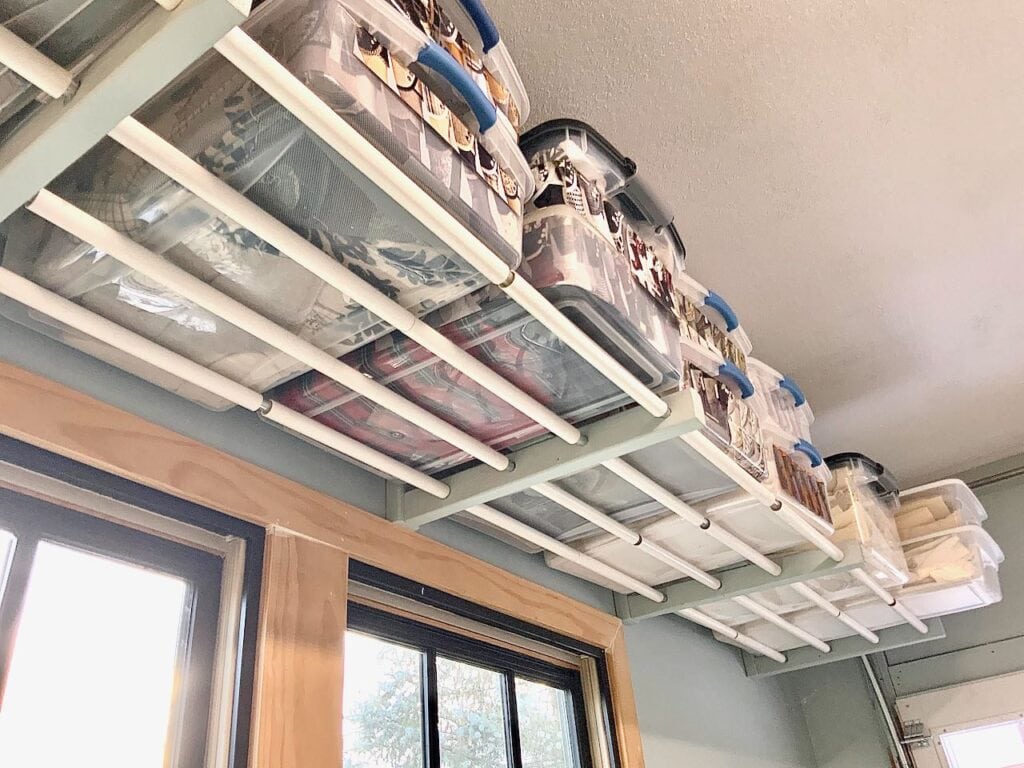
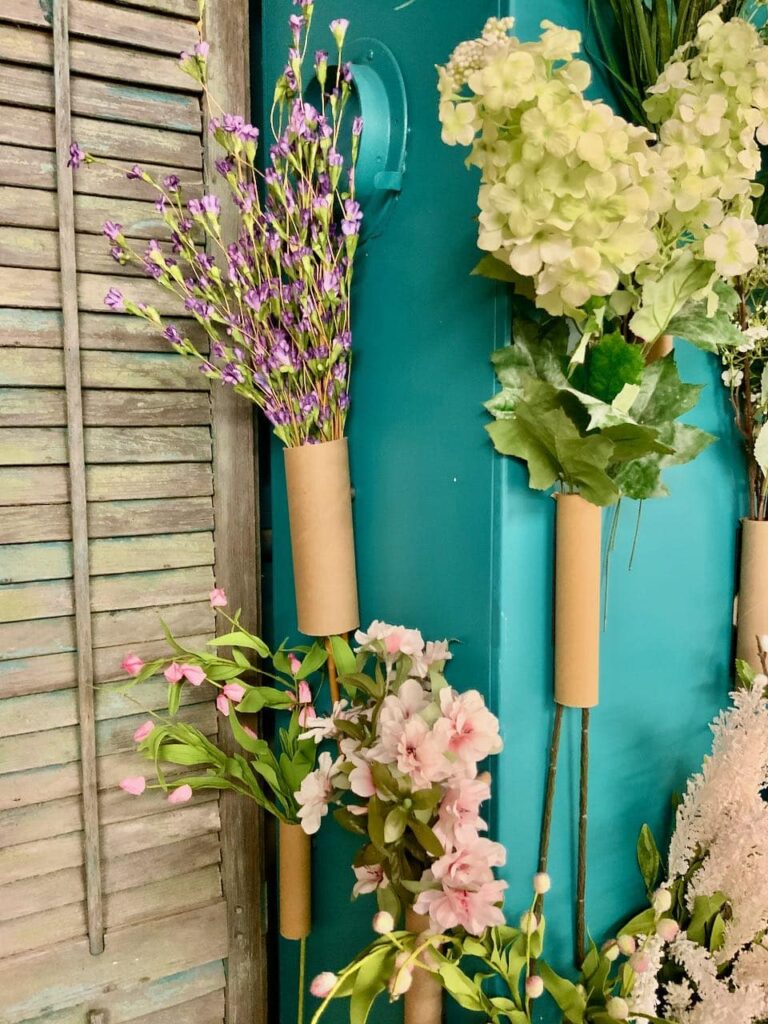
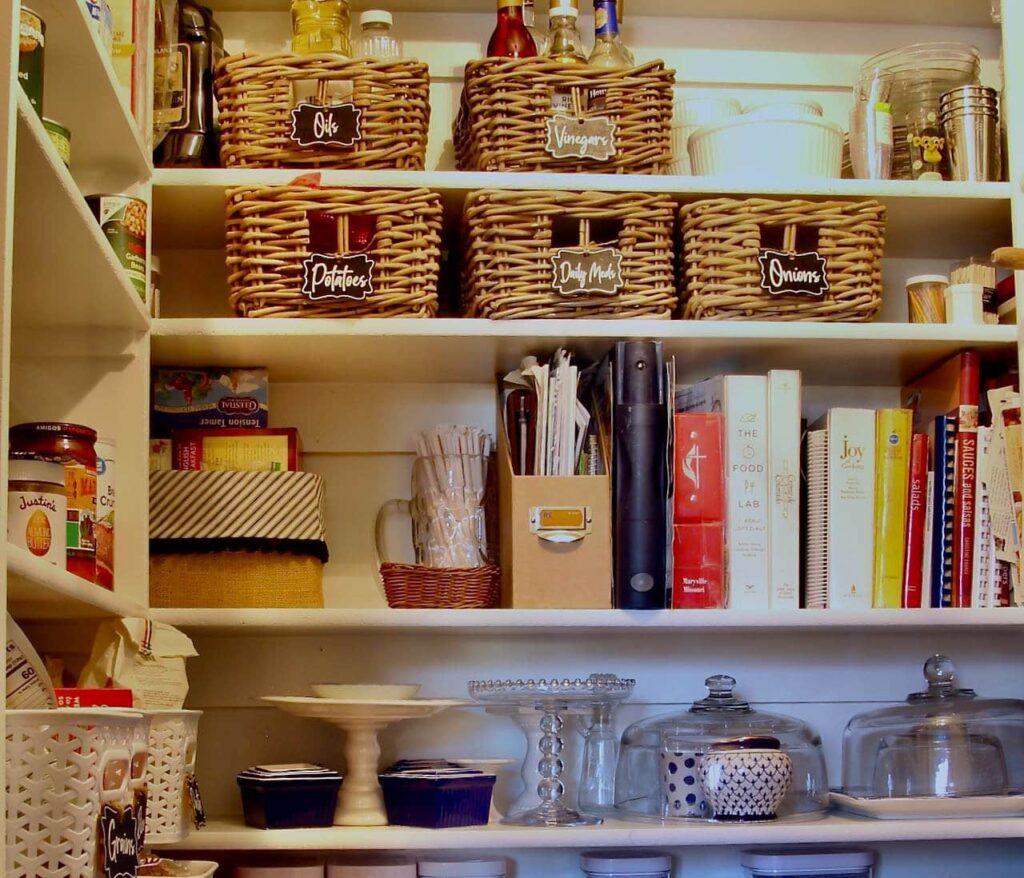
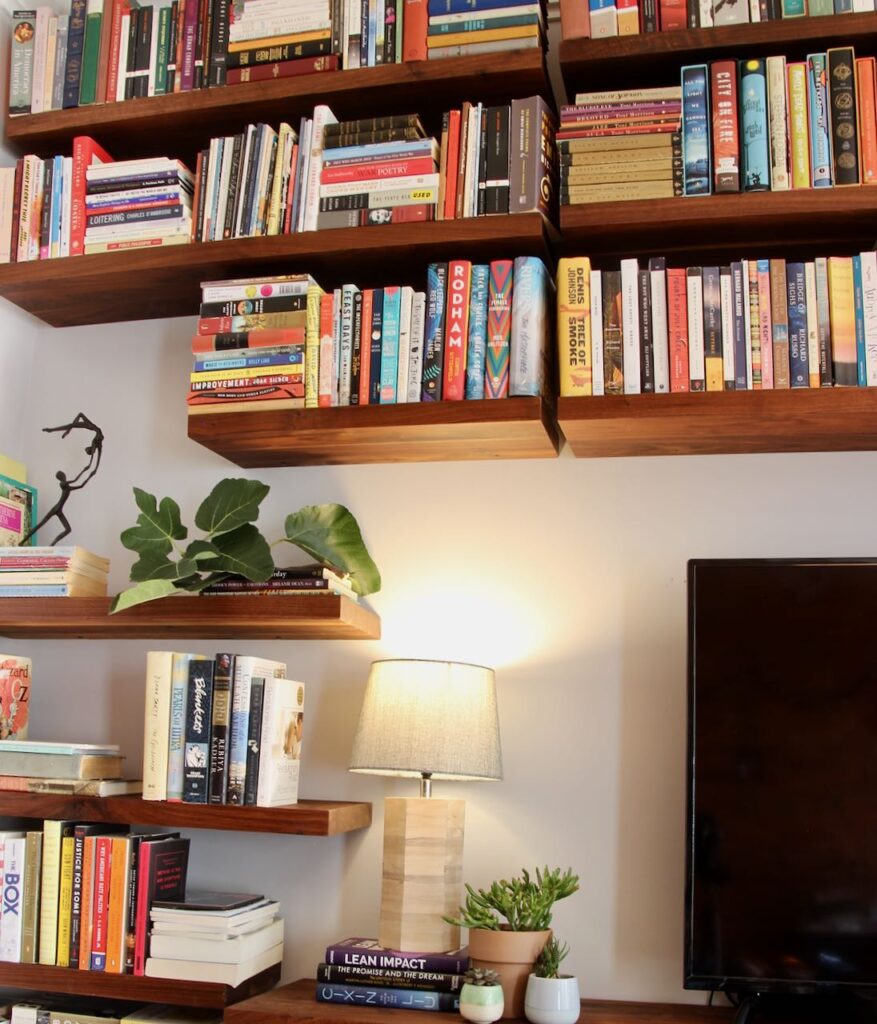
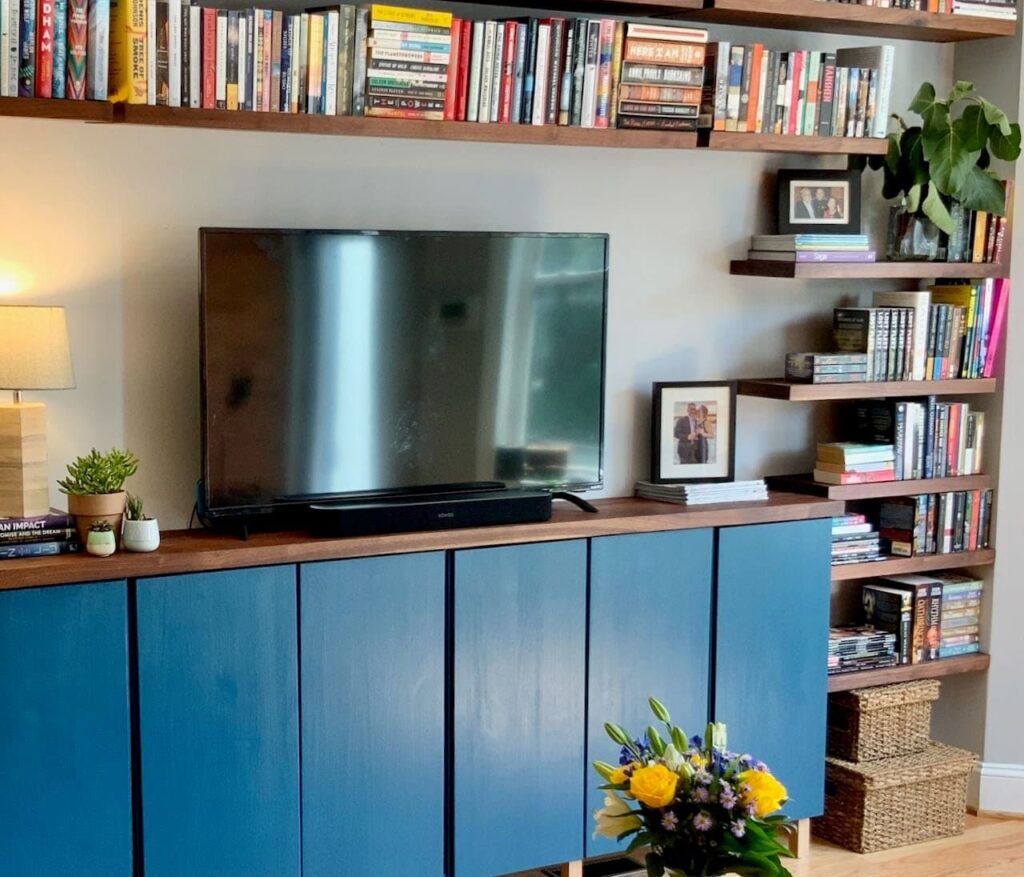
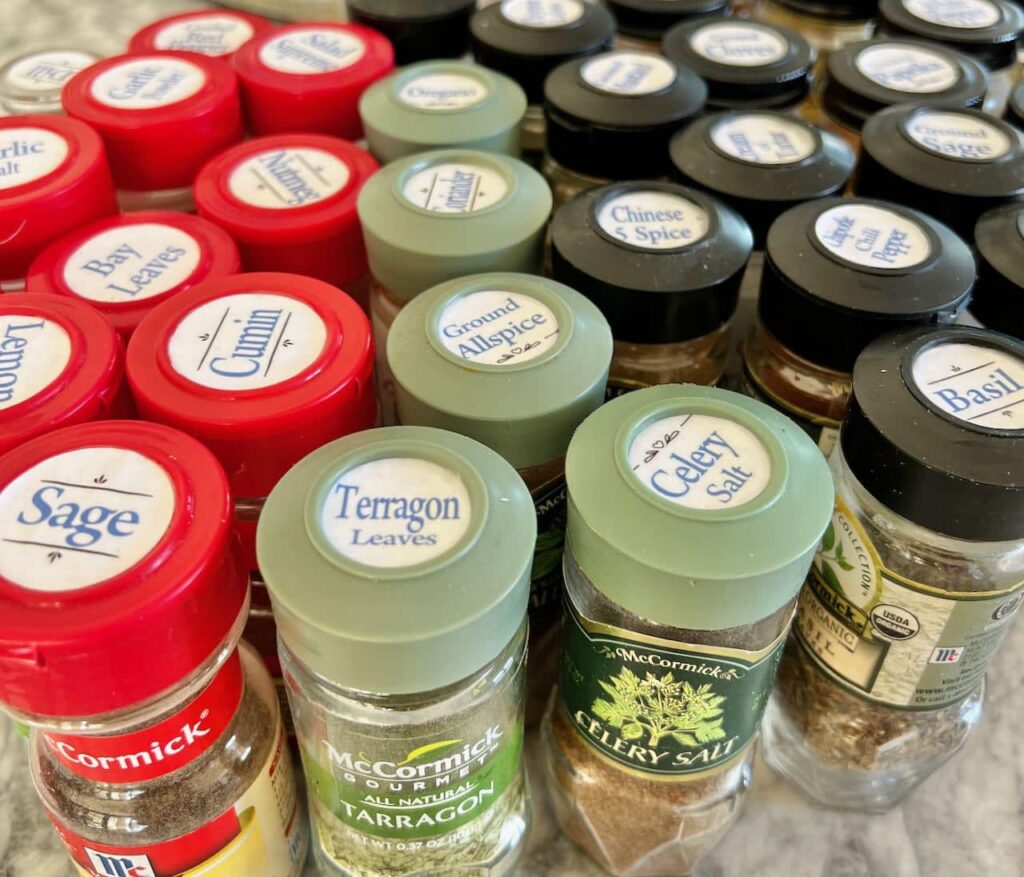




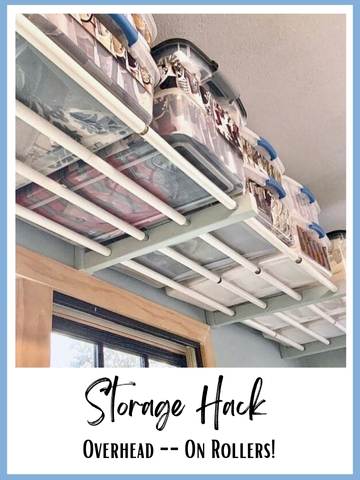
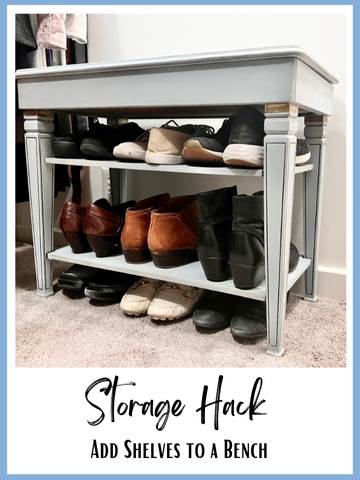
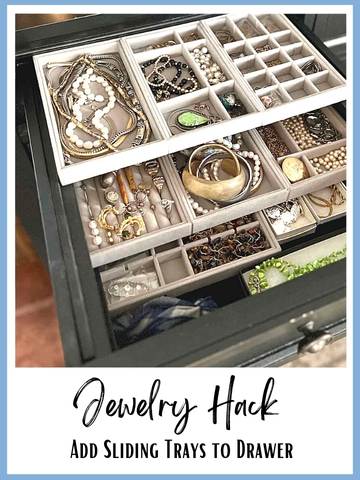
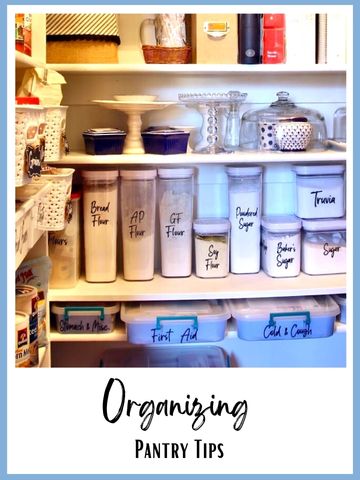
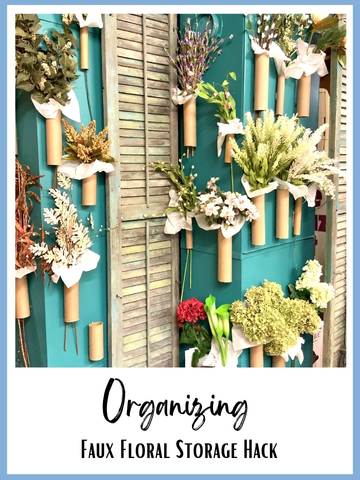
0 Comments
Trackbacks/Pingbacks